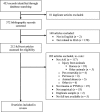Animal-Assisted Intervention for trauma: a systematic literature review
- PMID: 26300817
- PMCID: PMC4528099
- DOI: 10.3389/fpsyg.2015.01121
Animal-Assisted Intervention for trauma: a systematic literature review
Abstract
Animals have a long history of inclusion in psychiatric treatment. There has been a recent growth in the empirical study of this practice, known as Animal-Assisted Intervention (AAI). We conducted a systematic review of the empirical literature on AAI for trauma, including posttraumatic stress disorder (PTSD). Ten studies qualified for inclusion, including six peer-reviewed journal articles and four unpublished theses. Participants were predominantly survivors of child abuse, in addition to military veterans. The presentation of AAI was highly variable across the studies. The most common animal species were dogs and horses. The most prevalent outcomes were reduced depression, PTSD symptoms, and anxiety. There was a low level of methodological rigor in most studies, indicating the preliminary nature of this area of investigation. We conclude that AAI may provide promise as a complementary treatment option for trauma, but that further research is essential to establish feasibility, efficacy, and manualizable protocols.
Keywords: Animal-assisted Intervention; animal-assisted therapy; child abuse; human-animal interaction; posttraumatic stress disorder; trauma; veteran.
Figures
References
-
- American Psychiatric Association (2000). Diagnostic and Statistical Manual of Mental Disorders: DSM-IV-TR. Washington, DC: American Psychiatric Association.
-
- Balluerka N., Muela A., Amiano N., Caldentey M. A. (2014). Influence of animal-assisted therapy (AAT) on the attachment representations of youth in residential care. Child. Youth Serv. Rev. 42, 103–109. 10.1016/j.childyouth.2014.04.007 - DOI
Publication types
LinkOut - more resources
Full Text Sources
Other Literature Sources


